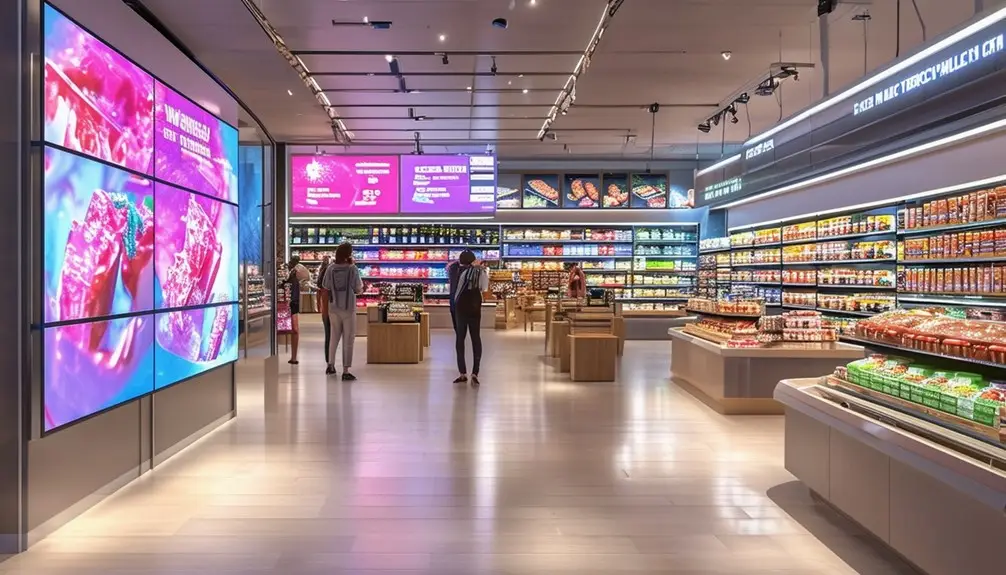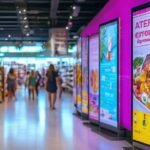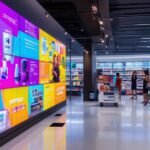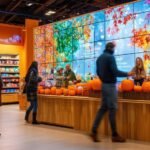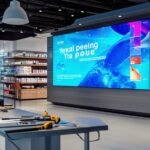Animated digital menu boards will skyrocket your customer engagement, drawing 10 times more eye contact than static displays. By aligning design goals with business objectives, you can attract foot traffic and highlight key items effortlessly. High-quality photos, videos, and animations can enhance visual appeal and emphasize premium products. Strategically place screens and plan animation flows to minimize visual competition. Analyze customer preferences to fine-tune content and maximize impact. Providers like Zoney Digital Signs offer customizable, dynamic solutions. To get the full benefit of these engaging features, let’s explore what these top providers can offer you.
Table of Contents
ToggleKey Takeaways
- Animated digital menu boards attract 10 times more eye contact than static boards, enhancing customer attention.
- Integrating animations creates a dynamic and engaging experience, boosting overall customer engagement.
- Leveraging high-resolution images and videos enhances visual appeal and highlights premium products.
- Strategic placement and animation flow across screens ensure consistent messaging and optimal customer engagement.
- Providers like Zoney offer customizable templates for professional-grade digital menu boards.
Impact on Customer Attention
Animated digital menu boards attract 10 times more eye contact than static ones, making them a powerful tool for capturing customer attention. By integrating animation on your digital menu boards, you can help create a dynamic and engaging experience that draws customers in. Data shows that well-executed animations can significantly enhance customer engagement, leading to increased sales.
When you strategically use motion on your digital menu boards, you enhance the overall look and feel of your display, making it more appealing. It’s essential, though, to ensure that these animations complement the content rather than distract from it. Random movement can actually deter customers from making purchase decisions, so your animations should be purposeful and aligned with your messaging.
Setting Design Goals
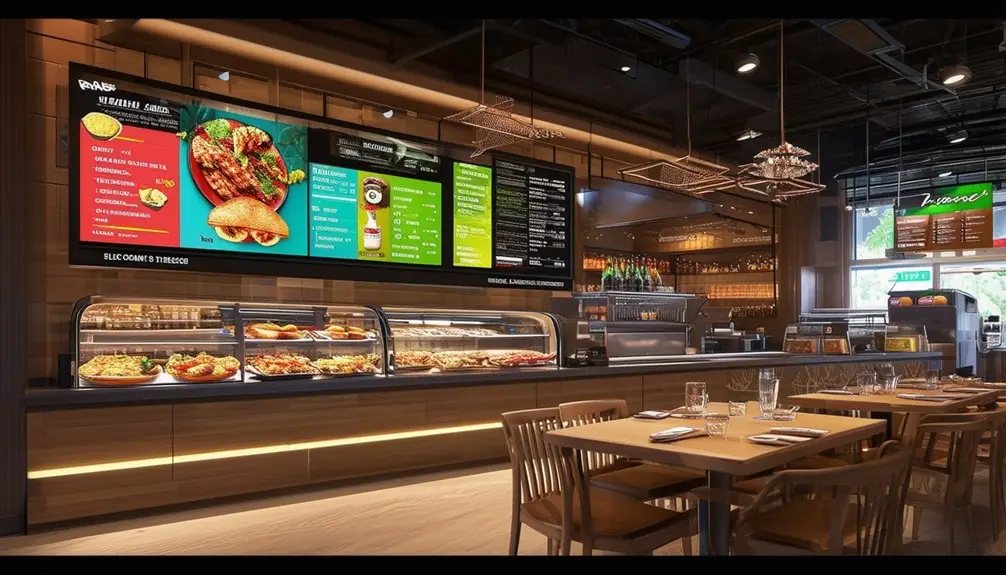
To maximize the impact of your digital menu boards, start by setting design goals that align with your business objectives. Prioritize goals like increasing foot traffic or highlighting specific items to guide the content. Leveraging existing menu assets can streamline the process and guarantee consistency.
Align With Objectives
Setting clear design goals for your digital menu boards guarantees they align perfectly with your business objectives and drive desired outcomes. Menu boards help in showcasing your offerings effectively, but designing digital versions requires a strategic approach. When you incorporate animated digital menu elements, you enhance customer engagement and influence purchasing decisions.
Start by identifying what you want your menu boards to achieve. Do you aim to increase foot traffic, promote specific items, or boost overall sales? These objectives should guide your design choices. For instance, strategic animations can highlight limited-time deals and promotions, making them more appealing to customers. Data shows that well-executed animations can notably boost sales and customer engagement.
Your digital menu boards should reflect customer preferences. Analyzing sales data and customer behavior helps you prioritize which items to promote. Animations should complement the content, not overshadow it. They should enhance the customer experience by making the menu easy to read and visually appealing.
Prioritize Menu Goals
Understanding your business objectives is just the beginning; you must now prioritize specific menu goals to create effective digital menu boards that truly drive results. Setting clear goals for your digital menus is important for alignment with your broader business objectives. Start by identifying what you want to achieve: Do you need to increase foot traffic, promote high-margin items, or highlight limited-time offers?
Your menu design should reflect these priorities. For instance, if boosting foot traffic is your goal, consider using strategic animations to grab attention from passersby. Highlighting limited-time offers with dynamic visuals can create a sense of urgency, encouraging immediate purchases. Use existing menu design assets to maintain brand consistency while streamlining the creation process.
Begin with a static design before adding animations to maintain a balanced approach that doesn’t overwhelm your audience. Strategic use of animations can enhance customer engagement by making key items stand out without detracting from the overall menu’s readability. By focusing on these objectives, you’ll maximize the effectiveness of your digital menus, driving customer engagement and ultimately, sales.
Utilizing Existing Assets
Leveraging your current assets for digital menu boards can greatly reduce both time and resources while enhancing the overall presentation. By utilizing high-quality photos and videos from your current content, you can elevate the appeal of your menu items without additional costs. Menu board templates and digital signage make it simple to integrate these assets seamlessly, adding a professional touch with minimal effort.
Animations can be particularly effective in capturing customer attention and conveying messages like freshness or premium quality. Repurposing saved assets for animations not only saves time but also gives your menu a dynamic and engaging feel. Movement can highlight key items, making them stand out and appear more enticing.
| Asset | Benefit |
|---|---|
| High-grade photos | Enhances visual appeal |
| Videos | Adds dynamic content |
| Animations | Highlights premium products, conveys freshness |
Free high-resolution images can significantly enhance your menu board’s visual content. These visuals, when combined with digital signage, ensure your menu stands out. By cleverly using your current assets, you can create an impressive digital menu board that attracts customers and promotes sales efficiently. Don’t let valuable content go to waste; leverage it to its full potential and watch your presentation soar.
Adapting to Restaurant Environment
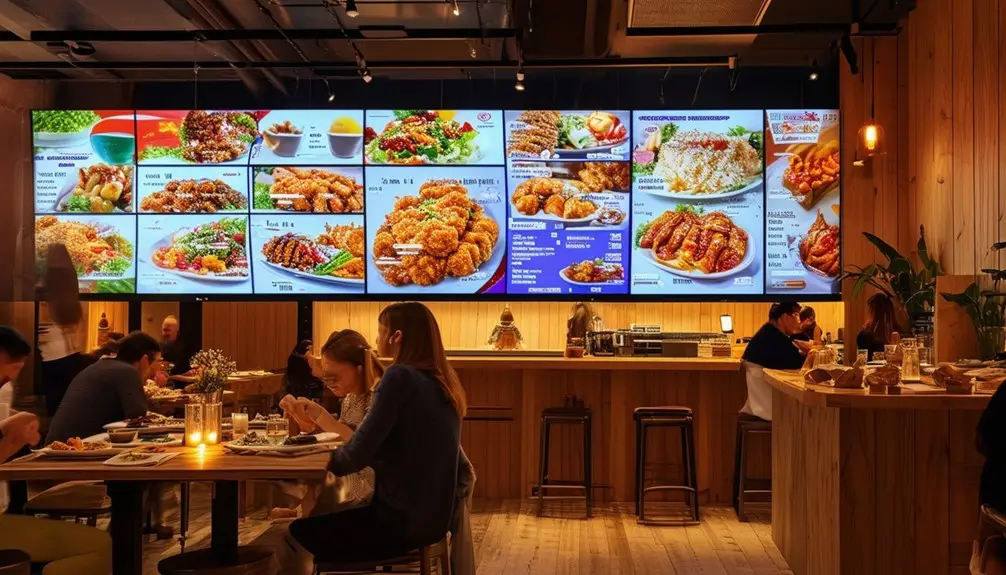
To enhance your digital menu boards‘ impact, evaluate the number and layout of screens to guarantee ideal placement in your restaurant. Analyze potential competition between visual elements to keep customer attention focused on key menu items. Strategically plan animation flow across multiple screens for a seamless and engaging experience.
Screen Placement Strategy
Effective screen placement in your restaurant starts with evaluating the number and layout of digital menu boards to optimize customer engagement and streamline their dining experience. Begin by analyzing your restaurant’s layout to strategically position the digital screens where customers naturally direct their attention. This guarantees that your digital menu content grabs attention immediately upon entry and while queuing.
Data shows that customers spend an average of 6-8 minutes deciding what to order. Positioning digital menu boards at eye level and in clear sight lines can reduce decision times and improve flow. Make sure that the screens are not too high or too low to maintain readability and visual appeal.
In addition, plan the animation flow between multiple screens to create a cohesive and engaging experience. A smooth progression between screens helps keep customer focus and enhances the overall dining experience.
It’s essential to verify that your hardware and software meet content needs for smooth operation. Investing in high-quality screens and reliable software can prevent disruptions and maintain a premium appearance. Lastly, align the digital menu boards’ mood with your restaurant’s ambiance and branding to create a consistent and inviting environment.
Competing Visual Elements
Balancing the visual hierarchy in your restaurant ensures that digital menu boards stand out without clashing with other marketing materials. Evaluate the layout and number of screens to ensure your boards don’t overwhelm the space. This assessment helps in maintaining an uncluttered and engaging customer experience. Planning the flow of animations between multiple screens guarantees cohesion, helping customers easily follow the information presented.
Consider the hardware and software capabilities to support the content demands of your digital boards. This helps animations run smoothly and look appealing, enhancing the overall customer experience. Additionally, your boards should reflect the mood and atmosphere of your restaurant, whether it’s a cozy café or a lively diner. This alignment can greatly boost customer engagement and satisfaction.
Design and animations should strategically appeal to customer emotions and preferences. Use colors, fonts, and motion that resonate with your target audience. Research shows that well-designed digital boards can influence purchasing decisions, making customers more likely to try new menu items or opt for upsells. By thoughtfully integrating digital boards into your restaurant environment, you can create a visually appealing space that enhances the customer experience and drives sales.
Optimal Animation Flow
When adapting your digital menu boards to the restaurant environment, evaluate the number and layout of screens to guarantee animations flow seamlessly and captivate customer attention. First, consider how multiple screens can create a cohesive and engaging experience. Planning the animation flow between them ensures that customers receive a consistent message, reducing cognitive overload and boosting engagement.
It’s vital to analyze how marketing materials might compete with digital menu content. By strategically placing animations, you can maintain visibility and highlight key items without overwhelming viewers. Make sure that your hardware and software can support the animations you intend to use. High-quality hardware ensures smooth playback, while robust software allows for flexibility and creativity in design.
Additionally, determine the mood you want to portray. Use animations to create an inviting atmosphere that aligns with your brand’s identity. Whether you aim for a lively, energetic vibe or a calm, sophisticated ambiance, your animation placement should reflect this mood.
Understanding Customer Preferences
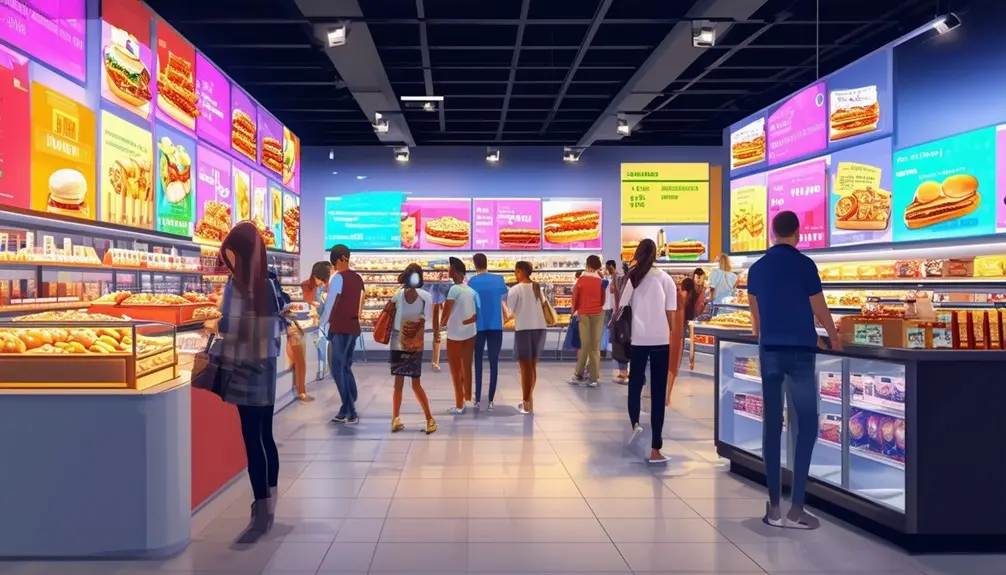
Grasping customer preferences through data analysis is vital for designing digital menu boards that captivate and convert. By understanding what your customers are drawn to, you can tailor your menu content and animation to boost both engagement and sales. Insights into customer behavior allow you to implement strategic animations that complement your offerings rather than distract from them.
To make your digital menu boards more effective, consider these key points:
- Analyze Customer Data: Understand peak times, popular items, and seasonal trends. This data helps you choose the best times and content to feature in your animations.
- Focus on Complementary Animation: Guarantee that animations enhance menu content, drawing attention to key items or promotions without overwhelming the viewer.
- Test and Optimize: Regularly test different animation styles and content placements to see what resonates most with your customers. Use this information to continually refine your approach.
Using animations correctly can attract 10 times more eye contact, but it’s essential to strike a balance. Excessive movement can be distracting. By focusing on customer preferences, you can create engaging digital menu boards that drive decision-making and, ultimately, increase your sales.
Key Features and Providers
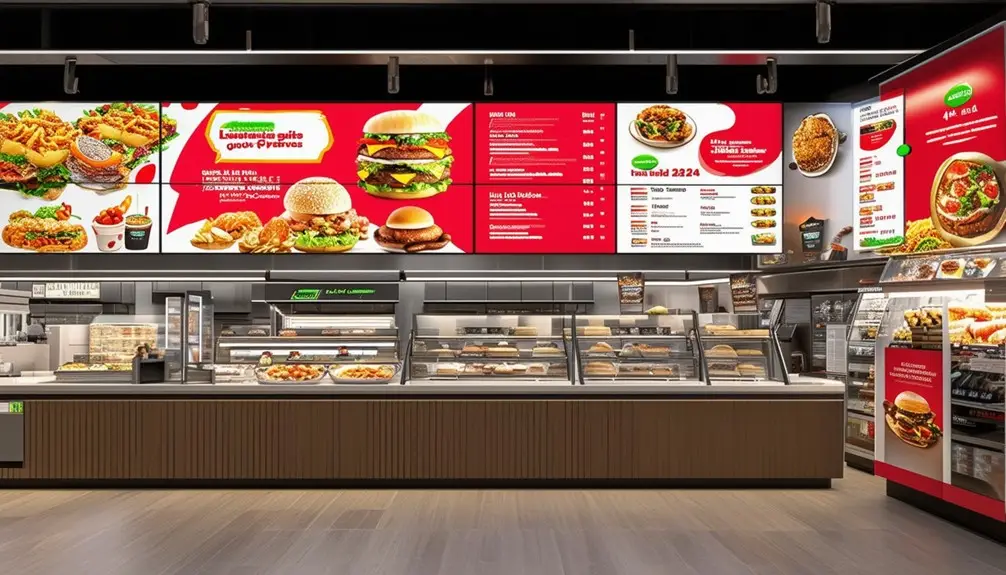
To optimize the impact of your digital menu boards, it’s important to explore key features and top providers that offer the best tools and expertise. Digital menu boards with animations attract 10 times more eye contact, making them a powerful tool to enhance customer attention. By strategically using animations, you can complement your content and boost sales, while also reducing perceived wait times.
Top providers offer customizable templates and professional-grade displays. Their solutions allow you to effectively display your menu on TV screens, ensuring clear visibility and engaging presentations. Zoney provides expert guidance for setting up cost-effective digital menu boards with animations, making it easier for you to differentiate your brand and increase customer engagement.
Animations on digital menu boards not only make your displays more attractive but also help in communicating promotions and upselling items. This leads to higher sales and a more dynamic customer experience. When choosing a provider, consider their expertise in animation and customization options to safeguard your digital menu boards meet your specific business needs. Investing in these key features will ultimately drive customer satisfaction and business growth.
Conclusion
Embracing retail digital menu boards with animations is like lighting a beacon that attracts customers with compelling visuals. You’ll boost attention, tailor designs to fit your restaurant, and resonate with customer preferences. By leveraging existing assets and selecting the right features and providers, you’ll guarantee a seamless integration. Don’t just keep up with the competition—stand out. Engage with the data-driven benefits and watch your customer engagement soar.
Frequently Asked Questions
What Is a Dynamic Menu Board?
A dynamic menu board is a digital display showcasing menu items and promotions with animations and videos. It captures customer attention, enhances visual appeal, and can be updated easily, driving brand recognition, engagement, and sales.
How Much Does a Digital Menu Cost?
Digital menus can cost from $500 to $2,000 per screen. Factors like hardware, software, and content creation influence this. Monthly software fees start at $10, making cloud-based options budget-friendly for many businesses.
Do Digital Menu Boards Increase Sales?
Yes, digital menu boards boost sales. They attract 10 times more eye contact, enhancing customer engagement and influencing purchases. Properly implemented animations differentiate your brand and promote deals, increasing impulse buys and driving foot traffic.
What Is the Difference Between a Digital Menu and a Traditional Menu?
You might think traditional menus are enough, but digital menus offer dynamic content, real-time updates, and easy customization. They boost customer engagement and sales, unlike static paper menus. Data shows businesses benefit from the switch to digital.
